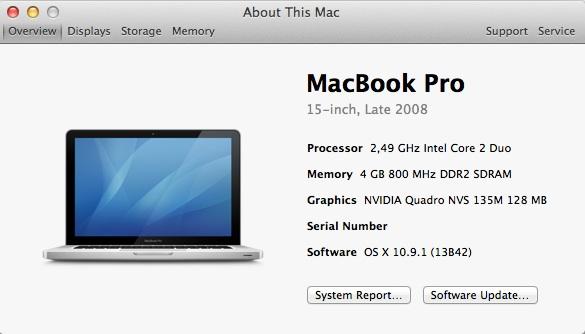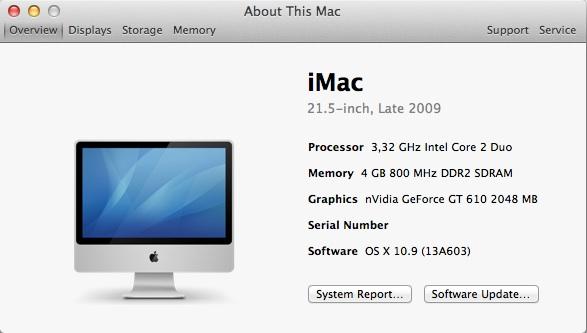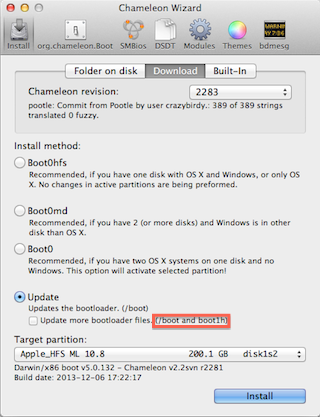-
Posts
10069 -
Joined
-
Last visited
-
Days Won
569
Content Type
Profiles
Articles, News and Tips
Forums
Everything posted by Hervé
-
Woaw, that's quite a mess you got there! It's going to need some rework of kexts and plists. I don't even think you have graphics acceleration for the integrated X3100 graphics at the moment. Do you have a translucent Finder bar at the top of the screen? Let's start at the beginning: open up a Terminal window and list your specs with lspci -nn command. Then posts us the results. We're gonna get down to the bare minimum and add kexts one by one to support the missing features afterwards. Then, we'll also look at the Chameleon version since your CPU is not even reported properly...
- 28 replies
-
- Lenovo
- Lenovo X61
-
(and 1 more)
Tagged with:
-

Can we add the Precision M6500 as a supported model in EDP?
Hervé replied to Mark's topic in The Archive
For your info, extracting the DSDT from OS X with Cham wizard to subsequently use it "as is" after placing the extracted .aml file in /Extra makes absolutely no difference at all: it's exactly the same as the table available in BIOS. DSDT files are only useful if patched. -
Mm, things are a bit messy with kexts in /E/E and in /S/L/E... Since you appear to use a myHack installation, you should place all of your added kexts to /E/E then run myFix (quick). As such move your Voodoo kexts out of /S/L/E and place them in /E/E. Who knows? maybe you have something conflicting within myHack.kext plugins... I see you also have a Chameleon boot plist in /E/E; its normal place is /E.
-
You need to identify your bluetooth adapter and give us the details. You may require to patch vanilla kexts, you may require a dedicated kext or your module might not be supported at all.
-
nVidia GPU always runs hot in that machine, OS X making much heavier use of graphics acceleration than Windows. What changes does your above SSDT bring ? Better CPU power management, which OS X clearly handles less favourably than Windows?
-
No matter the OS, gaming on Latitude D Series with X3100 graphics... basic games maybe. MLPF would not make games any worse off than they would be under Lion on that laptop since it's totally reversing ML to Lion 10.7.5 graphics handling.
-
If you have your own existing bootpack, choose "your own", if you don't choose "Generic".
- 28 replies
-
- Lenovo
- Lenovo X61
-
(and 1 more)
Tagged with:
-
Intel wireless cards are not used by Apple; never have been; so you'll never find a driver, they're not supported. You have to consider a replacement card (but is there a NGFF/M.2 model currently supported under OS X ?) or a USB alternative.
-
Link is right above in post #2... Or look in Articles pages of the web site, there's an article with links.
-
As I said, you can also have ML (with a special hack).
-
Look at the Compatibility Chart in the EDP menu at the top of your page. Then you could also head for EDP->Supported Models with Guides section of the forum (for special ML installation - X3100 graphics are no longer supported since ML). Re: OS X installation procedure, please browse through the EDP pages of our web site before heading for the forum, you'll find all that you need.
-

D630n - Mavericks 10.9 GM/Mainstream/Updates installation
Hervé replied to Hervé's topic in The Archive
-
It means hardware replacement may be required. Re: wifi, you were told everything over a month ago, so go back to p1 of this thread and re-read answers you got.
-
Whilst the above parameters were also tested Ok with BIOS A17, CPU performance was subsequently found to be degraded with that latest BIOS version. As such, it is highly recommended to stick to BIOS A15. During testing, degraded performance was encountered on 2 different M4300, each fitted with Intel C2D T8300 2.4GHz CPU and the apparent problem repeatedly confirmed through benchmarking: BIOS A15 -> Geekbench (32bit): 3391 BIOS A17 -> Geekbench (32bit): 2470
-
I would try the the ribbon cable "upside-down" if I were you; at least you know you'll have tried all possibilities...
-
Installing Extra is a manual menu option in myHack 3.3.1...
- 28 replies
-
- Lenovo
- Lenovo X61
-
(and 1 more)
Tagged with:
-
Are you sure you did not plug the Zif ribbon cable the wrong way? I did it myself the 1st time and could not see my SSD until I realised my mistake...
-
WARNING: I only just noticed that since updating to BIOS A17, my T8300-based M4300 scored much lower in GeekBench (under 2470 for a test that lasts just over 2mins) than it were initially with BIOS A15 (over 3300 for a test that lasts just over 1min). I think it's therefore strongly advisable to stick to BIOS A15. To revert, I copied extracted HDR file M4300A15.hdr to a FAT32 formatted USB key (sole file on the key) and used the process listed above (battery out/power cable Out and In whilst pressing [END] key). M4300A15.hdr.zip
-
Looks like you have a cache issue. Boot with options/flags -f UseKernelCache=No -v and see how it goes. If you get to Desktop, re-run myFix (quick) to rebuild your cache, assuming this is a myHack + OSXL boot pack installation. If not, start from scratch with that method, it works.
-
Mmm, You bought some really older and slower RAM, but that'll do I guess. DDR2-800 would have been a much better choice.
-
I think we're gonna need a better picture, eh?
-
There's no reason why it would only start Mavericks in safe mode and there's no reason why you would boot your myHack installer in safe mode either... Something is wrong: BIOS parameters? USB installer? Intel wireless you did not remove or disabled? It'll be one of those. Check your settings and follow the guide very carefully.
-

Dell Vostro 200 - Snow Leopard/Lion/Mountain Lion/Mavericks
Hervé replied to Hervé's topic in The Archive
Retail/mainstream Mavericks 10.9 running perfectly after a fresh re-installation. Complete fresh ML 10.8 & Mav 10.9 installations can be made with myHack3.3.1 + attached boot pack. This caters for full built-in hardware, including LAN and audio, so EDP may not be required. For other hardware and add-on graphics card, deal as required. Also includes revised DSDT (of Inspiron 530s origin from InsanelyMac) that fully supports Sleep & Wake. System is now 100% operational. Vostro200ST_ML-Mav_bootpack.zip -





